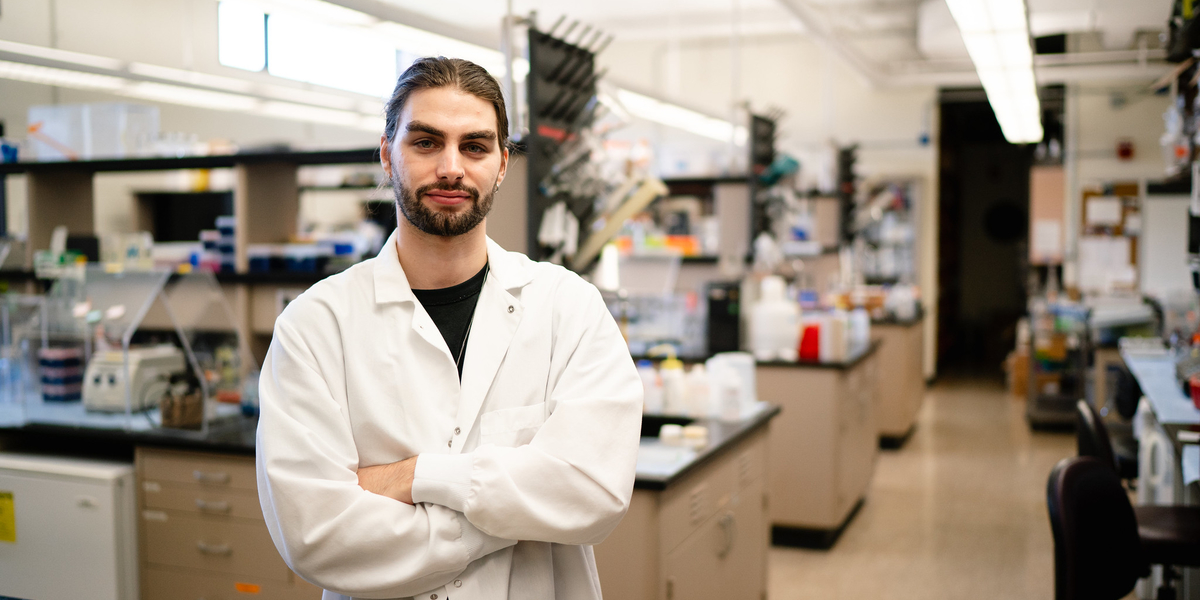
No one knows what aliens look like – if such life exists at all. Perhaps life on other planets is dominated by tiny microbes, complex proteins and a splash of water. Perhaps there are intelligent beings with oversized skulls and bulging eyes that speak in “bleep bloops.” Our best (and worst) guesses are the stuff of cinematic speculation.
Whatever the case, many scientists agree that a world in which extraterrestrial life exists is statistically plausible. If the day of “first contact” ever arrives, Peter Winslow, astrobiologist and graduate student in the Biochemistry, Molecular Biology and Biophysics (BMBB) department wants to be ready. “If we ever discover life beyond our planet, it’d be so cool to be on the list of people NASA calls,” says Winslow.
Winslow’s chances might be better than most. As a recent recipient of the NASA Future Investigators in NASA Earth and Space Science and Technology (FINESST) award, a highly-sought-after program for graduate students interested in space exploration, innovation and technology, Winslow conducts research he describes as “kind of out there” to study the origins of life — how life could emerge now, in the future or on different planets.
Investigating the origins of life could prepare scientists for what to expect (or what questions to ask) if humans ever really do make contact with life “out there.” He’s just not stuck on what it means for the past. “I don't think the origin of life is interesting in and of itself if you're not taking into account the possibility of what it means for the future,” he says. “I’m more interested in asking ‘how can the basic units of life vary?
Because Winslow can’t study the diversity of alien life, he studies the next best thing — proteins that don’t exist. At least, not in nature. Modern technology makes it possible for scientists to construct basic biological units that don’t exist out of biological units that do. In his case, Winslow is studying human-engineered proteins that were generated at random using a library of known amino acids. These proteins are great models for precursors of life in an alternate Earth. Think primordial soup.
In a science communication competition called Science in Seconds, Winslow compared his research to Jurassic Park. However, the protein “dinosaurs” he’s bringing to life aren’t like anything we’ve seen in fossil records. In fact, they’re nothing like we’ve seen at all. Miraculously, many of the novel proteins were successful in binding to ATP, the primary source of cellular energy. It’s Winslow’s goal to find out how.
“How the heck are they doing a function that’s similar to what modern proteins do?” he wonders. “The fact that these proteins have never existed, and they're so different from what exists today, means that we really don't know what to expect.”
He and undergraduates in the Seelig lab are working together to run tests — both standard and advanced — to characterize a lucky few of these proteins. They’re constantly kept on their toes, often with “totally weird” and “unexpected” results. It’s exactly the kind of exploration that keeps Winslow excited. “There’s a very plausible world in which we discover something out there that’s alive, and it may not be what we’re used to,” he says.
If a career in astrobiology wasn’t already ambitious, Winslow also mentors three undergraduate students in BMBB Professor Burckhard Seelig’s lab, acts as the grad student representative for his program, attends prestigious conferences and recently won the Science in Seconds CBS award for science communication.
Winslow credits his surreal reality to his community, his older brother (“it always comes back to him,” says Winslow), Seelig and his labmates in the Seelig Lab.“This was really an endeavor built upon the shoulders of everyone who came before me,” says Winslow. He hopes to continue strengthening relationships with other University of Minnesota astrobiologists.
When asked if he would take on an opportunity to go to space in search of extraterrestrial life, he says, “Would I go to the moon? In a heartbeat. Would I go to Mars? Probably not. I need to come back.” – Adara Taylor